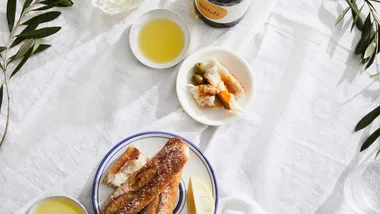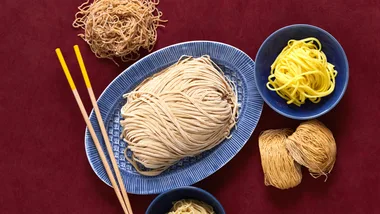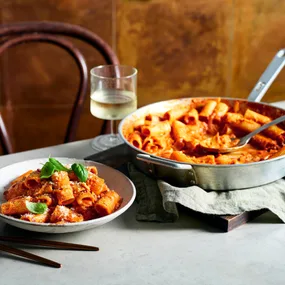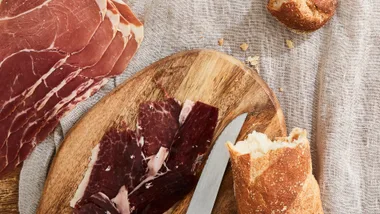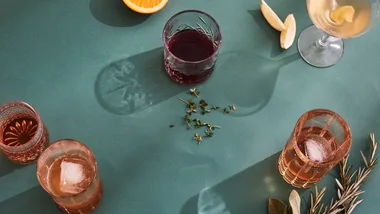It’s crucial to make the distinction between fresh pasta and dried pasta. They’re different products and they require different handling. Fresh pasta absorbs sauce more readily, so it’s more suited to wet dishes such as lasagne, or meat ragù, or a tomato- or cream-based sauce. Dried pasta, on the other hand, can be used for all of these but is particularly good with oil-based sauces – spaghetti marinara or spaghetti aglio e olio, for instance.
I think handmade pasta is vastly superior to bought pasta. I always use organic eggs and very good-quality “00” durum wheat flour because this gives the best flavour and texture to the pasta. I like to use Sala Cereali brand farina di grano tenero tipo “00” (available from Simon Johnson). I’ve made pasta using a cheap supermarket brand of “00” flour with okay results but I find the pasta is quite soft and lacks resistance.
I usually make a batch of one kilo of flour to nine eggs, which is enough for an entrée for about 15 people, but for a smaller batch of 500gm flour, use four eggs. The ratio of egg to flour will vary with flours, temperatures and the size of the eggs, but it’s easier to add flour to a wet dough than the other way around. The dough should come together but not be sticky on your hands; knead it for about 10 minutes, till it’s firm but smooth. Make your dough in the afternoon of the evening you want to eat the pasta, and then dry it in a draught-free room. This is very important. When I worked for Stefano de Pieri, he’d make his fresh pasta only in the late afternoon, so that by the time he cooked it in the evening it would be perfectly dry, rather than brittle.
One of the uses of the hand-cranked pasta-rolling machine is to make the dough smooth and to work the gluten in the wheat to give the pasta a firm, strong texture. I remember Guy Grossi preferred his pasta super-smooth so that it had a beautiful silken quality to it; others prefer their pasta a little more rustic.
Dried pasta is made from hard durum wheat and water, mixed together and then pushed through a die and dried. The pasta factories in Italy that produce very high-quality artisan dried pasta buy the best durum wheat available, use bronze dies, and air-dry their pasta very slowly. The slow drying preserves the flavour and integrity of the wheat, and the bronze dies give the pasta a rough texture which grabs at the sauce, as opposed to the super-smooth finish commonly seen in commercially made pastas created using plastic dies. Artisan pasta can seem quite expensive compared to the mass-produced examples, but if the pasta is going to be the centre of the dish then surely, I think, it is worth spending a little more on it. The difference of only a few dollars across a meal for four, say, is certainly noticeable in terms of the flavour and texture of these beautiful pastas.
Pasta needs to be cooked in ample – and properly salted – water. You should use four litres of water for every 450gm pasta, and for this amount I recommend two tablespoons of salt. This quantity is imperative to ensure the pasta is well seasoned, and to ensure it can move around in the saucepan and not become gummy. Adding salt to the finished dish never tastes quite as good.
The water must be at a full rolling boil before you add the pasta. This way, when the correct amount of pasta is added to sufficient water, the pot will return to the boil very quickly.
Once it’s done, pasta should be drained immediately, but don’t drain all of the water – keep some of it back. This starchy, salty water is an essential ingredient in itself. You should already have all the other components ready to go: the sauce hot, the bowl in which you are going to serve the pasta warm, the parmesan grated and the table set.
If you have made a ragù or a Bolognese, don’t just blob it on top; mix the sauce with the pasta in the pan – toss and work it in, adding a little pasta water to give it the correct consistency and body. Then add a knob of butter to enrich the sauce.
For oil-based sauces, use lots of oil and use a very good one. The sauce should be beautifully fragrant with garlic, parsley and perhaps the addition of prawns, pipis or chilli. I always finish the pasta with another fresh splash of extra-virgin olive oil before serving.
 Antonia Pesenti
Antonia Pesenti
